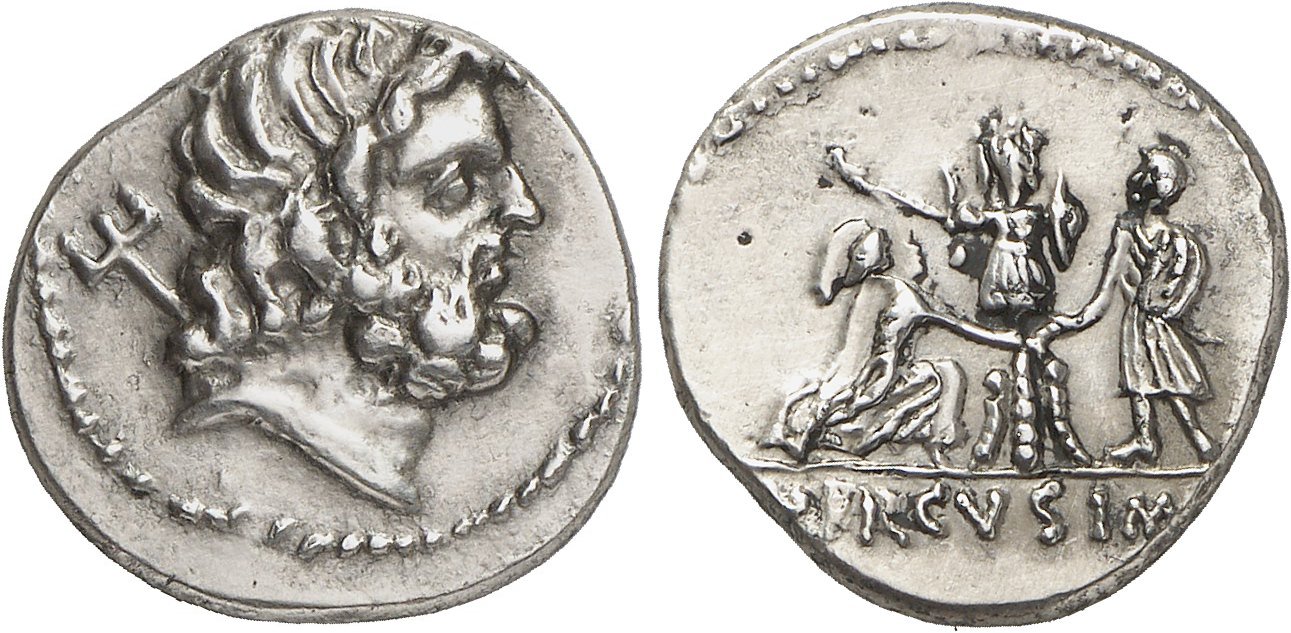S 1472 - Ionian Sea, silver, denarii (RRC 510/1 - 41 BCE)
From SILVER
41 BCE - 41 BCE Silver 430 kg
Description
| ObverseInscription or printing placed on the obverse.: | Bearded head of Neptune to right, trident over his far shoulder |
| ReverseInscription or printing placed on the reverse.: | MVRCVS IMP (Latin).On the right, bareheaded soldier (Murcus?) standing left, clasping his right hand with the right hand of a female figure (Roma?), on the left, kneeling to right, behind them both, military trophy |
Mint and issuing power
| MintIdentifies the place of manufacture or issue of a numismatic object.: | Ionian Sea | Ancient regionAncient region.: | Modern countryModern country: | AuthorityIdentifies the issuing power. The authority can be "pretended" when the name or the portrait of X is on the coin but he/she was not the issuing power. It can also be "uncertain" when there is no mention of X on the coin but he/she was the issuing power according to the historical sources: | Roman Republic |
Chronology
| FromIdentifies the initial date in a range assigned in a numismatic context. | 41 BCE | toIdentifies the final date in a range assigned in a numismatic context.. | 41 BCE | PeriodTime period of the numismatic object.: Roman from 30 BC |
Physical description
| MetalThe physical material (usually metal) from which an object is made.: | Silver |
Median weightMedian of the weights of numismatic objects (in grams). in grams | 3.55 | DenominationTerm indicating the value of a numismatic object. Examples: tetradrachm, chalkous, denarius.: | denarius |
StandardStandard.: |
Image

S 1472 - Rome, silver, denarii (RRC 510-1 - 41 BCE).jpg [1]
References
| Die study referencePublication of the study: | Campana 20191Campana 2019 | ||
| Coin series referenceReference to coin series study: | RRC2RRC, n° 510/1 | ||
Obverse dies distribution
| FrequencyFrequency of specimen in distribution. ᵖ | Number of obversesNumber of obverse dies. ᵖ (o) | % (o) | Number of coinsNumber of coins. (n) | % (n) | Die nameName(s) of the die(s). |
| 2 | 2 | 33.33 | 4 | 6.15 | 5;6 |
| 3 | 1 | 16.67 | 3 | 4.62 | 4 |
| 7 | 1 | 16.67 | 7 | 10.77 | 3 |
| 13 | 1 | 16.67 | 13 | 20 | 2 |
| 38 | 1 | 16.67 | 38 | 58.46 | 1 |
| Total | 6 of 6 | 100.01 | 65 of 65 | 100 |
Reverse dies distribution
no distribution is available
Quantification
| Number of obversesNumber of obverse dies. ᵖ (o) | 6 | Number of singletons (o1)The number of singleton coins. ᵖ | |
| Number of reverse diesNumber of reverse dies. (r) | 27 | Number of coinsNumber of coins. (n) | 65 |
| Coins per obverse dieNumber of coins per obverse die. (n/o) | 10.83 | Coins per reverse dieNumber of coins per reverse die. (n/r) | 2.41 |
| Reverse per obverse ratioRatio of obverse dies divided by reverse dies. (r/o) | 4.5 | Percentage of singletons (o1)number of coins (n) divided by the number of singletons (o1) ᵖ | % |
| Original number of dies (O) (Carter 1983 formula)The estimation of the number of coins according to Carter 1983 ᵖ | 6.05 | Coins struck if 20,000 as average productivity per dieCoins made if the average productivity for obverses (according to Carter) is 20,000. ᵖ | 121,000 |
| Original number of dies (O) (Esty 2011 formula)The estimation of the number of coins according to the singleton formula in Esty 2011 ᵖ (O) | 6.61 | Survival rate if 20,000 as average productivity per dieSurvival rate if average productivity is 20,000. ᵖ | 0.00054 |
| Coverage (o = % of O) (Esty 1984 formula)Esty 1984 - coverage (% of O) ᵖ (o = % of O) | % | Die productivity if survival rate 1/2,000Average productivity if survival rate is 1/2,000. ᵖ | 21,487.6 |
| Weight of silver (in kg) if 20,000 coins per die (O = Carter formula)Carter 1983 * Median weight * 20000 (*10 if gold or electrum) ᵖ | 430 kg <br /> 430 kg | Die productivity if survival rate 1/5,000Average productivity if survival rate is 1/5,000. ᵖ | 53,719.01 |
Remarks